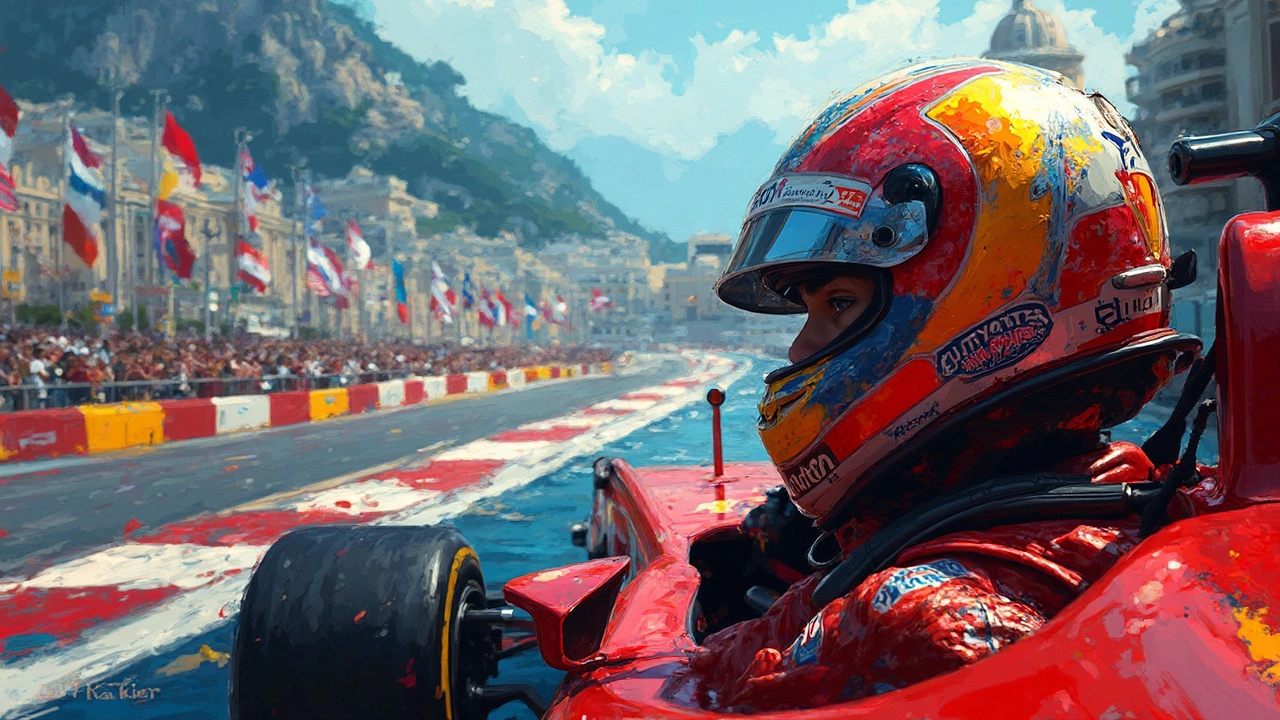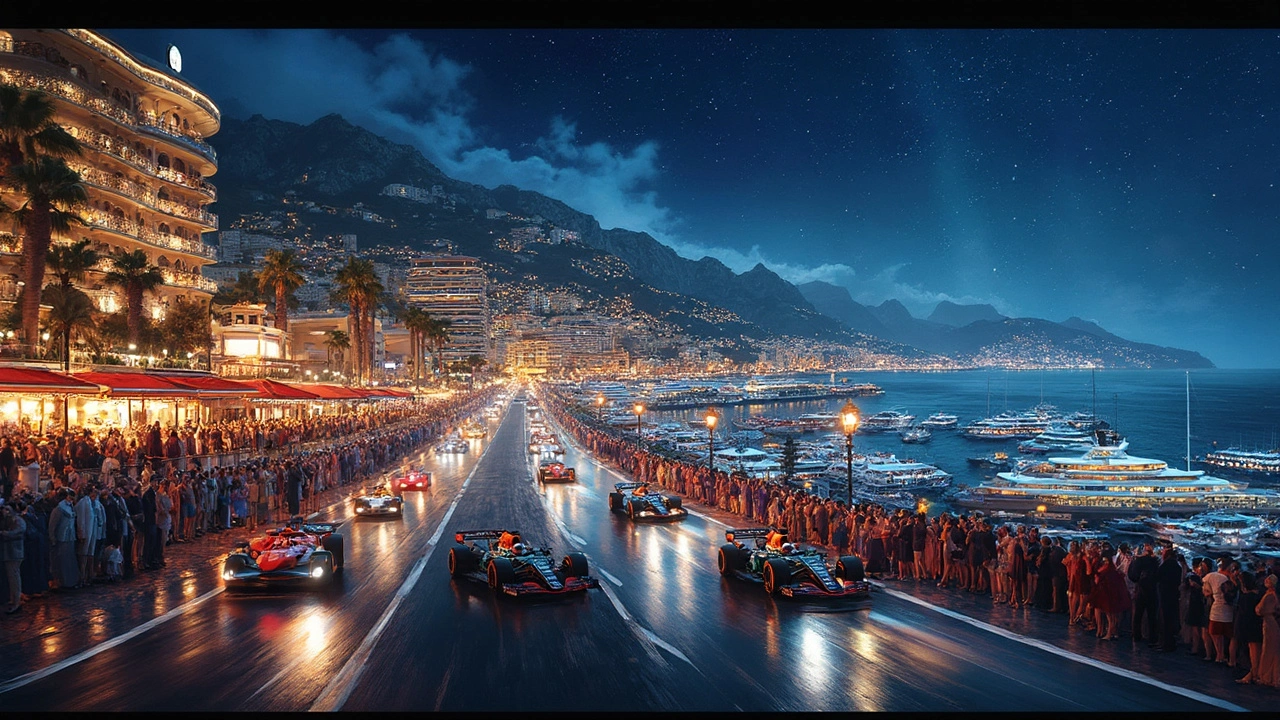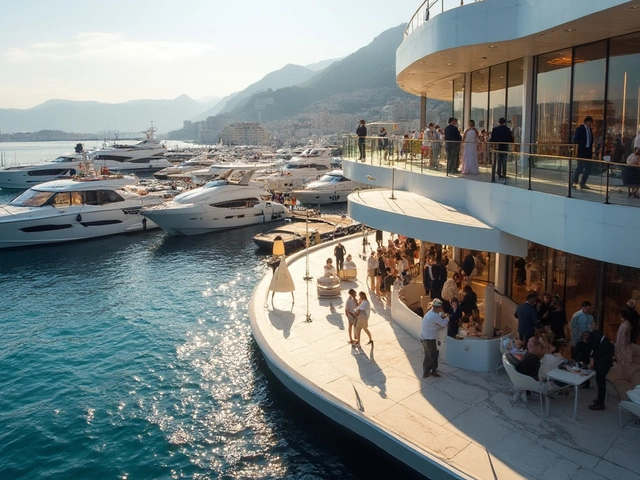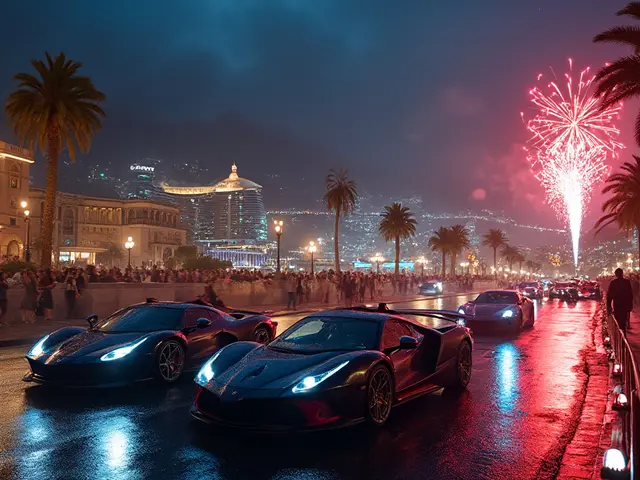Ever wonder what makes the Grand Prix de Monaco so captivating? It's not just the speed. It's a blend of tradition, challenge, and the unique atmosphere of racing through the streets of Monte Carlo. But this year, there's a twist. Racing at night isn't just about illumination; it's a whole new ball game for the drivers.
Monaco isn’t your regular race track. It's a tricky, narrow circuit where overtaking is as scarce as a rainy day in Nevada. Wearing their helmets and heart rates on high, drivers maneuver through tight corners flanked by unforgiving barriers. Every turn comes with its own story, a test of skill where one mistake can be the race's defining moment.
So why the secrecy? Not everything at Monaco is as glittery as it seems. Behind the scenes, teams are busy tweaking strategies to adapt to racing under the stars. It's less about top speed and more about who can best handle the unique twists of the track when the sun goes down. We'll uncover these secrets and more as we dive into the world of Monaco's racing night.
- Monaco's Magic: More Than Just a Race
- Mastering the Circuit: What Drivers Face
- Strategy Under the Stars: Night Racing
- Behind the Glamour: Hidden Challenges
- Tips for Fans: Making the Most of Your Visit
- Monaco's Place in F1 History
Monaco's Magic: More Than Just a Race
The Grand Prix de Monaco isn't just any race; it's a prestigious event that combines adrenaline with the glamour of the French Riviera. Imagine Formula 1 cars zooming through legendary streets like Casino Square and the famous tunnel. It's a unique blend of speed, strategy, and style, all wrapped up in one package.
Monaco, one of the most iconic locations in F1 circuit, hosts this event annually and every time it feels like a magnet for racing enthusiasts. The race is as much about the track as it is about the backdrop. The shimmering Mediterranean Sea, super yachts anchored at the harbor, and the historic buildings lining the course make it a breathtaking spectacle.
What sets Monaco apart is its tight, unforgiving track. It's the narrowest track in the F1 calendar and challenges drivers with its sharp turns and elevation changes. The Portier corner, for example, is a spot where some big names have met misfortune. Drivers must master each turn because a slip-up could mean the end of their race.
This race offers more challenges due to the absence of run-off areas, making precision crucial. Unlike other races, where overtaking might come easily, in Monaco, it's all about securing the perfect spot during qualifying to gain a competitive edge.
Monaco isn't just a battle for drivers; it's also a must-see for fans. Watching in person brings a different thrill. But don't think you can wander in at the last minute. Tickets sell out quickly, and accommodation in this dazzling city can be quite the treasure hunt. Fans often plan months in advance to snag a spot in stands or even a viewing place on a yacht.
So, if you ever find yourself planning a trip, keep these details in mind. The Monaco Grand Prix is indeed more than just a race—it's an experience, a tradition, and a celebration of the exciting world of Formula 1.
Mastering the Circuit: What Drivers Face
The Grand Prix de Monaco is renowned not only for its glitz but for a circuit that truly tests a driver's mettle. Dodging through the narrow streets lined with towering barriers isn't just about keeping a firm grip; it's a mental game requiring focus and finesse.
Just 3.337 kilometers long, this track is the shortest in F1, but don't let its size fool you. Packed with 19 thrilling turns, it challenges even the most seasoned racers over 78 laps. The track's elevation changes and the number of corners make overtaking a Herculean task. Many races here are won in the qualifiers due to the limited overtaking spots.
Here's a quick look at what makes the circuit special:
- Turn 1: Sainte Devote - A tight right turn welcoming drivers with an immediate uphill climb that tests their acceleration.
- Mirabeau and Grand Hotel Hairpin - Among the slowest turns, this series requires precision braking and smooth steering.
- Tabac Corner and Swimming Pool Complex - Fast, exhilarating sections where drivers show their gutsy side. A wrong move here means a brush with the barricades.
The Monaco circuit demands more than technical skills. Weather plays a crucial role, too. The Mediterranean climate can flip quickly, turning a dry race into a slippery affair. Team strategists keep a keen eye on forecasts, adjusting tire choices just minutes before the race.
Understanding the circuit's demands is key, and those who do often find themselves on the winner's podium. It's no wonder races here often result in surprising finishes, leaving fans guessing till the very last lap.
Strategy Under the Stars: Night Racing
Night racing at the Grand Prix de Monaco isn’t your usual F1 experience. With the streetlights glimmering off the glossy surfaces of the F1 cars, it’s more than just a visual delight. But there’s a lot happening behind those steering wheels in the night hours.
For starters, cooler temperatures mean a whole change in how the tires react. Teams have to adapt their strategies to these weather changes. Tire grips behave differently at night, challenging teams to balance speed without sacrificing control. The teams that manage to hit the sweet spot often find themselves cruising past the finish line ahead of others.
Visibility is another big factor. The Monaco track is already quite narrow and winding, and under artificial lighting, every shadow can play tricks on the drivers' eyes. Precision is key, and drivers rely heavily on every cue from their team radio to adapt on the go. Plus, thanks to modern technology, drivers use advanced telemetry to make informed split-second decisions.
Telemetry data becomes the unsung hero at night races. Teams constantly adjust race strategies with real-time information flowing in through hundreds of thousands of data points. This data helps optimize fuel usage, minimize tire wear, and ensure drivers can safely but swiftly navigate through the iconic hairpins and chicanes of the track.
Performance strategies differ significantly from day racing. The cooler air means engines perform a little better, so teams often tweak the car's aerodynamics to harness that extra edge. Engineers play a critical role, constantly analyzing data to suggest dynamic adjustments, all while the car is barreling down the track.
To top it off, night races often see more unexpected events, from altered team tactics to sudden rain showers. Flexibility becomes a crucial trait, and teams with backup plans for every conceivable scenario usually have the upper hand.
So, whether you're in the pits or watching from home, knowing these behind-the-scenes strategies can add a whole new layer of excitement to the experience. Night racing here is more than just a race; it’s a complex chess game played at breakneck speeds under the shimmering Monaco sky.

Behind the Glamour: Hidden Challenges
Sure, the Grand Prix in Monaco is dripping with glamour, but beneath that sheen lies a series of hidden challenges that every team has to grapple with. Let's peel back the layers and see what's under the surface.
First up, it's the logistics. Ever tried parking in a bustling city during peak hours? That’s a mere warm-up compared to setting up an F1 weekend in the tight streets of Monte Carlo. Teams must cram their garages, hospitality suites, and all their gear into the Principality's tiny marina district. It’s no small feat and demands incredible precision and planning.
Then there's the unpredictable weather. While Monte Carlo generally enjoys sunny skies, coastal weather can change on a dime. A surprise rain shower means teams need to be at their strategic best. Dry to wet, wet to dry – tire choices become a game within the game in racing.
Let’s not forget the track itself. The circuit's complexity is notorious in the F1 world. Tight turns like the iconic Fairmont Hairpin and the Tunnel section can turn into bumping grounds for even the top drivers. The margin of error: almost nonexistent.
What about the locals? Residents often grow weary of the hustle that the Grand Prix brings. It’s a challenge for organizers to balance the excitement of the race with the everyday needs of the populace.
Finally, think about the event's economic aspect. The glittery show isn't just for fun – it’s a business. Keep everyone happy, from the spectators willing to pay top dollar for views, to sponsors who fund the spectacle – it’s a delicate dance.
So, under the sparkling facade, the Monaco Grand Prix houses complex layers of challenges that make it both the grandest stage and one of the toughest places to claim victory.
Tips for Fans: Making the Most of Your Visit
Planning to soak up the action at the Grand Prix in Monaco? Here's how to make it an experience you won't forget. First off, let’s talk tickets. They can be tricky to get, so it's best to book early. That way, you secure a good spot, preferably with views of the harbor and the glamorous Monte Carlo Casino.
Next, what do you pack for such a stylish event? Don't forget sunscreen and comfortable shoes. Trust me, you’ll be doing a lot of walking. And a pair of binoculars could really elevate your viewing experience, letting you catch those thrilling moments up close.
The weekends leading up to the race can be packed with activities. Check out driver interviews and autograph sessions. They can be gold for any fan seeking a more personal connection with the stars. Also, make time for the fan zones. These areas often feature simulations, vintage car displays, and entertainment.
Getting around town might require some local know-how. Monaco is compact, but when you've got thousands of fans converging on one place, things can feel congested. Public transport and walking are your best bets for navigating the city without a stress headache.
- Test your luck with Monaco’s famed casinos. It’s a must-see, but remember, they have a dress code. Party-wise, there are loads of events and yacht parties, especially around the Port Hercules area, but be ready to spend.
Monaco has a rich history within the F1 world, so don’t skip the museums. The Prince's Car Collection features a stunning array of classic cars that any car enthusiast would appreciate.
| Activity | Recommended Time |
|---|---|
| Visit the Casino | Evening/Night |
| Autograph Sessions | Late Afternoon |
| Fan Zones | Morning |
And finally, because eating well is part of the experience, don't miss the chance to try some iconic Mediterranean cuisine. The street-side cafes and local eateries offer some delightful options, or go upscale in the Les Moneghetti district for a fancier meal.
Monaco's Place in F1 History
Monaco is more than a race; it's a spectacular show of glitz, skill, and history rolled into one adrenaline-pumping event. Since its inception back in 1929, the Grand Prix de Monaco has been a cornerstone of the Formula 1 calendar. Why? Well, it’s partly due to its illustrious heritage and the fact that it's considered one of the Triple Crown of Motorsport alongside the Indy 500 and the 24 Hours of Le Mans.
Doling out victories at the Monaco track is almost like being knighted in the F1 universe. Legends such as Ayrton Senna, who holds the record for the most wins here, made their mark in these narrow streets. He won here not just once or twice, but six times, gripping this title like no other.
The mix of iconic landmarks and the tight street circuit make this race one of the most challenging for drivers. You can’t exemplify Monaco's magic without mentioning the famous tunnel, the Loews Hairpin, and the Rascasse corner – all lending to its reputation as the ultimate driver's circuit.
Over the decades, this small principality has witnessed a multitude of innovations in the racing world. From daring overtakes to strategic pit stops, every race unfolds with stories worth retelling.
Monaco isn’t just iconic; it’s essential, embodying the soul of F1 racing. Its presence on the F1 calendar is a nod to history, honoring the evolution of motorsport. So every time the engines roar here, it’s not merely a race; it's a nod to the legacy and future of F1.




